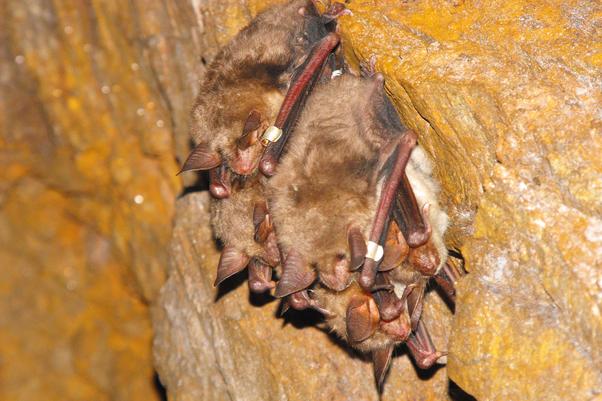Bedrohte Daten für bedrohte Arten
Alle in Deutschland vorkommenden Fledermausarten sind gefährdet oder vom Aussterben bedroht und von großer Bedeutung für den Naturschutz. Da alle Fledermausarten durch nationales Recht geschützt sind und in der von der Europäischen Union erlassenen FFH-Richtlinie (92/43/EWG des Rates) aufgeführt sind, ist eine kontinuierliche Überwachung der Fledermauspopulationen von nationaler und internationaler Bedeutung. Um ein effizientes Monitoring zu erreichen, benötigen wir Informationen über tatsächliche Populationsgrößen und -trends sowie Daten über die aktuelle und vergangene Populationsdynamik. Aber nicht nur die Fledermäuse sind gefährdet, sondern es wurde im Laufe der Jahre von freiwilligen Fledermausforschern und Naturschützern eine beträchtliche Menge an Daten gesammelt und archiviert, die jedoch nie durch standardisierte, moderne Statistiken zentral ausgewertet wurden und die nun immer mehr in Vergessenheit geraten. In einem vom BfN (Bundesamt für Naturschutz) geförderten Projekt möchten wir deshalb mit modernen statistischen Methoden bisher unveröffentlichte Daten standardisieren und mit publizierten Daten kombinieren, um die jährlichen Populationsgrößen im bundesweiten Maßstab zu schätzen. Darüber hinaus werden wir Daten aus individuell markierten Populationen verwenden, um die Daten zur Populationsgröße durch Daten zur Populationsdynamik zu ergänzen. Schließlich werden wir die Daten standardisieren und eine umfassende Datenbank zur Populationsdynamik von Fledermäusen aufbauen, die uns helfen soll, die Auswirkungen des Klima- und Umweltwandels auf die Fledermauspopulationen zu überwachen.
Zentrale Forschungsfragen:
Wie entwickelten sich die Populationen verschiedener Fledermausarten in den letzten Jahrzehnten?
In welche Richtung entwickeln sich die Trends derzeit?
Wie robust sind aktuelle statistische Schätzmethoden?
Wie sehen die Überlebens- und Reproduktionsraten aus und haben sie sich in den letzten Jahren verändert?
Wie sieht die demographische Struktur in den Populationen aus und hat sie sich im Laufe der Zeit verändert?
Gibt es geographische Unterschiede zwischen der Populationsdynamik und welche Faktoren könnten einen Einfluss haben?
Wie können wir die Effizienz für zukünftige Monitoring-Erhebungen für den Fledermausschutz verbessern?
Bisherige Ergebnisse:
BATLAS - digitaler Fledermausatlas
https://batlas.infoZitiervorschlag:
BATLAS (2023): Portal für Fledermauspopulationstrends. Universität Greifswald (Hrsg.): Bedrohte Daten von bedrohten Arten - Projekt im Rahmen einer Zuwendung gefördert durch BfN mit Mitteln des BMUV.Artikel:
- Stapelfeldt B, Scheuerlein A, Tress C, Koch R, Tress J, Kerth G. (2022). Precipitation during two weeks in spring influences reproductive success of first-year females in the longlived Natterer’s bat. R. Soc. Open Sci. 9: 211881.
https://doi.org/10.1098/rsos.211881 - B. Stapelfeldt, C. Treß, R. Koch, J. Treß, G. Kerth, A. Scheuerlein (eingereicht). Longterm field study reveals that warmer summers lead to larger and longer-lived females only in northern populations of Natterer's bats.
- C. Reusch, A. Scheuerlein, L. Grosche, F. Meier, J. Gampe, M. Dammhahn, J. v. Schaik, G. Kerth (in Revision). The risk faced by the early bat: individual plasticity and mortality costs of the timing of spring departure after hibernation.
Konferenzbeiträge:
Fritze, M., Mayr, S., Berg, J., Busse, P., Harder, J., Hoffmeister, U., Horn, J., Koch, M., Maetz, G., Malaske, S., Meisel, F., Meschede, A., Petermann, R., Rackow, W., Roßner, M., Thiele, K., Wielert, S., Kerth. G., Scheuerlein, A. (2022): BATLAS - A database with integrated automatic analysis of count data for estimating population trends. Tagung der Deutschen Fledermausforschenden (TDFF), Universität Greifswald, 21.-23.10.2022, Greifswald-Wiek.
Fritze, M., Scheuerlein, A., Kerth, G. (2022): Ehrenamtliches Monitoring und die Bedeutung für Artenschutz und Forschung. Sommertagung "Fledermaus-Monitoring und die Rolle des Ehrenamtes", Deutsche Fledermauswarte, BAT e.V., Uni Greifswald, 11.06.2021, Zitadelle Spandau, Berlin.
Fritze, M., Scheuerlein, A., Berg, J., Busse, P., Horn, J., Oldenburg, W., Petermann, R., Rackow, W., Röse, N., Sauerbier, W., Wielert, S., Kerth, G. (2021): Populationstrends von Fledermäusen. Fledermauskundliche Herbsttagung, Arbeitskreis Fledermäuse Sachsen-Anhalt & Deutsche Fledermauswarte, 21.11.21, Schloss Mansfeld, Mansfeld.
Scheuerlein, A., Fritze, M., Kerth, G. (2021): Überlebensraten von Fledermäusen anhand von Beringungsdaten. Sommertagung "Digitalisierung im Fledermausschutz", Deutsche Fledermauswarte, BAT e.V., Uni Greifswald, 19.06.2021, Zitadelle Spandau, Berlin.
Fritze, M., Berg, J., Horn, J., Rackow, W., Röse, N., Sauerbier, W., Wielert, S., Scheuerlein, A., Kerth, G.,(2021): Fledermaus-Populationstrends aus Zähldaten – erste Ergebnisse und Überlegungen. Sommertagung "Digitalisierung im Fledermausschutz", Deutsche Fledermauswarte, BAT e.V., Uni Greifswald, 19.06.2021, Zitadelle Spandau, Berlin.
Projektverantwortliche:

